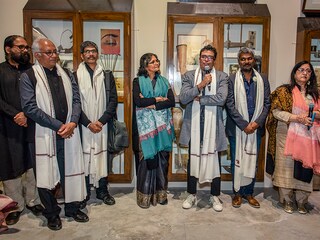Venice Biennale 2019: India's pavilion, celebrating 150 years of Gandhi, is in w...
The exhibit features seven works propagating Mahatma Gandhi's messages, by artists such as Atul Dodiya, Jitish Kallat and Nandalal Bose


The exhibit "Our Time for a Future Caring", celebrates 150 years of Mahatma Gandhi, and has been listed among the top 10 country pavilions from a total of 90, by the Financial Times and leading art website artsy.net, alongside the US, Switzerland, Poland and debut country Ghana.
On the two preview days, May 9 and 10, teams from New York"s Museum of Modern Art, London"s Tate Modern, Art Basel and international auction house Sotheby"s visited the India pavilion.
Participating artist Atul Dodiya’s installation, Broken Branches (2002), comprises nine glass-fronted wooden cabinets, filled with objects including hand-coloured framed photographs, artificial limbs, tools, found objects and billboard paintings. It is a reflection of the artist"s Gandhian upbringing in Porbandar, the birthplace of the Mahatma.
The exhibit is relevant, yet unique and that"s what attracts people, believes artist GR Iranna. His 2010 work Naavu (We Together), a wall installation made of hundreds of padukas (wooden footwear) has had many at the Biennale intrigued. Taking from the Vedas and the Upanishads, the work propagates the effectiveness of non-violence. "I have seen so many visitors take photographs of my and other artists" works. They also read all the wall text. This level of interaction means that we have done something right," says Iranna on a phone call from Venice.
Indian art: The need for government supportWhile the reviews are unanimously good, the concern is India"s ad-hoc participation. "India"s long-standing absence from a platform like the Venice Biennale, even when much smaller countries manage to participate, represents the continual neglect of our successive governments," says artist Jitish Kallat. His captivating video installation ‘Covering Letter’ (2012), features a fog screen representation of Gandhi"s letter to Hitler before the onset of World War II in 1939, urging the German leader to reconsider his violent means. This is touted as among the best works at the Biennale this year. "I hope this is not just a one-off instance and the coming governments are encouraged to participate more productively in the art and culture of the country," adds Kallat.
Artist Atul Dodiya shares the same concern. "The Venice Biennale is a vital platform for artists from all over, and we have been absent from it for a long time. I hope that the Indian government ensures that we participate every year,” he says.
This year, India is showcasing a total of seven art pieces, including the works mentioned earlier. Nandalal Bose"s Haripura Panel (1938), commissioned by Gandhi himself, depicts India"s rural population. Fragments (1993) by Rummana Hussain"s is a five-piece installation made from terracotta, wood, brick and mirror. The simple materials are at the centre of the work, which shows the concept of the earth taking shape as a nation, a philosophy often preached by the Mahatma. An untitled work by Shakuntala Kulkarni (2010-12) comprises two cane sculptures, seven photographs and accessories from the project ‘Of Bodies, cages and armours’. This work ties in with Gandhi"s bamboo stage platforms, from which he addressed the people of the nation. Kulkarni also shows the material as armour for several women in India, who earn a living making bamboo crafts. Untitled (2019) by Ashim Purkayastha, acyclic on canvas with stone sculpture, talks about the stone as a tool of violence and protection and Gandhi"s path of peace.
The Venice Biennale continues until November 24 and attracts more than 6 lakh international visitors in each edition.
First Published: May 13, 2019, 11:00
Subscribe Now